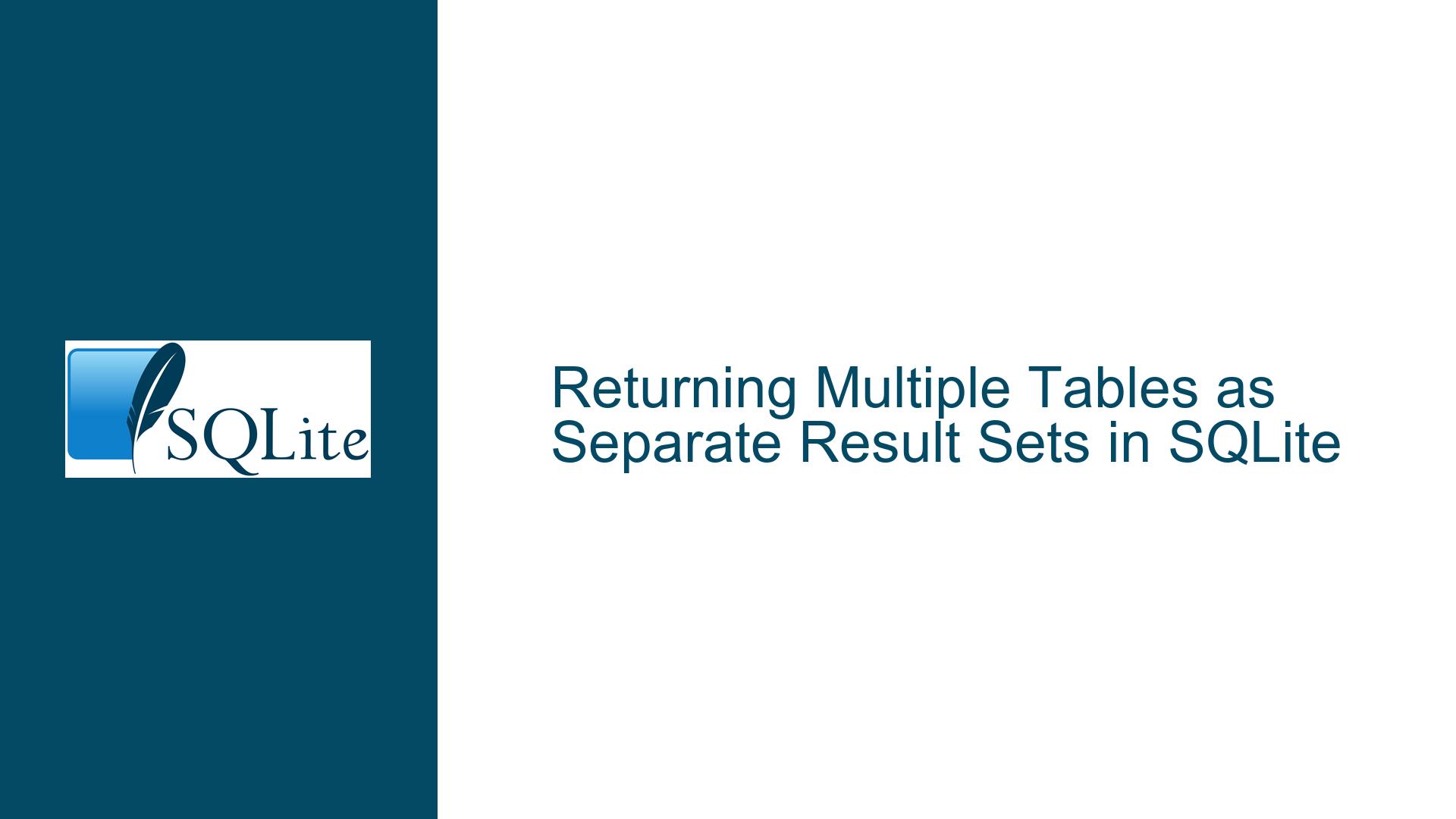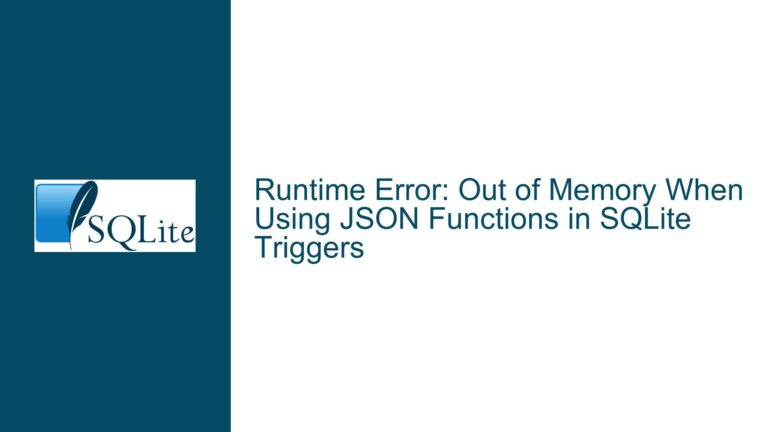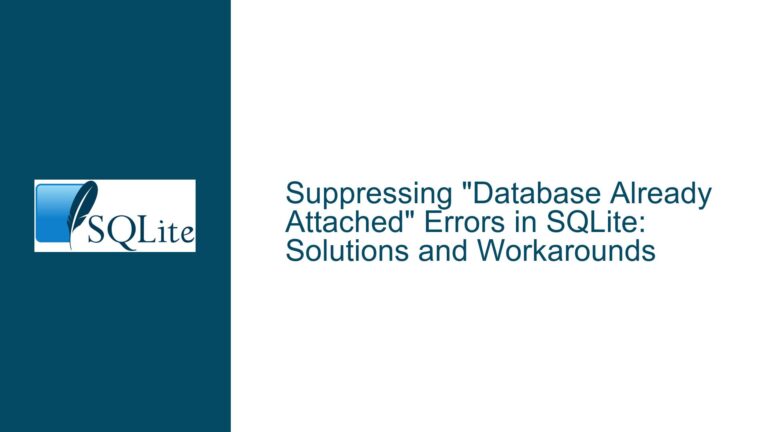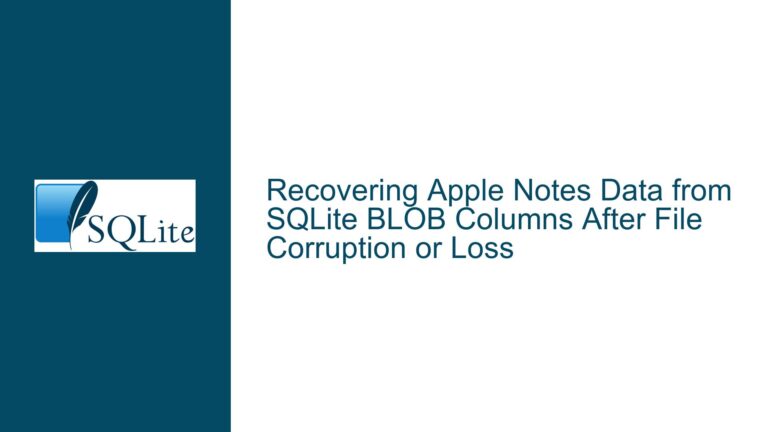Returning Multiple Tables as Separate Result Sets in SQLite
Understanding the Need for Multiple Result Sets in SQLite
The core issue revolves around the desire to return multiple tables or result sets from a single SQLite query, structured in a way that allows easy separation and access in application code. The goal is to avoid the monolithic table structure that SQLite typically returns when joining or combining data from multiple tables. Instead, the user wants a result format where each table’s data is distinctly separated, resembling a nested structure like [[table_1: [a: 1, b:2]], [table_2: [a: 1, b:2]]]. This would allow the application to directly access table_1 and table_2 without additional parsing or splitting of the result set.
The challenge arises because SQLite, like most relational database management systems (RDBMS), is designed to return a single result set per query. This result set is a flat table structure, even when data is sourced from multiple tables or Common Table Expressions (CTEs). While SQLite provides powerful tools for querying and manipulating data, it does not natively support returning multiple independent result sets in a single query. This limitation necessitates creative workarounds to achieve the desired output.
Why SQLite Cannot Return Multiple Independent Result Sets
SQLite’s architecture and the SQL standard itself are fundamentally designed around the concept of a single result set per query. When a query is executed, SQLite processes the SELECT statement, applies any joins, filters, or transformations, and returns a single table-like structure. This structure consists of rows and columns, where each row represents a record and each column represents a field. Even when using CTEs or subqueries, the final output is always a single, unified result set.
The user’s request to return multiple tables as separate result sets is not supported because SQLite does not have a mechanism to package multiple independent result sets into a single response. This is not a limitation unique to SQLite; it is a characteristic of most RDBMS systems. The SQL standard does not define a way to return multiple result sets from a single query, and SQLite adheres to this standard.
Attempts to use constructs like UNION ALL or JOIN to combine data from multiple tables result in a single, flat result set. For example, the query WITH table_1(a,b) AS (SELECT 1,2), table_2(a,b) AS (SELECT 3,4) SELECT * FROM table_1, table_2 returns a single table with columns a, b, a, and b, which is not the desired outcome. The user wants the data from table_1 and table_2 to remain distinct and separately accessible.
Workarounds and Solutions for Returning Multiple Result Sets
While SQLite does not natively support returning multiple independent result sets, there are several workarounds and techniques to achieve the desired outcome. These solutions involve structuring the query and application code in specific ways to simulate multiple result sets or to facilitate easy separation of data.
1. Using Multiple Queries
The simplest and most straightforward approach is to execute multiple SELECT statements, one for each table, and collect the results in the application code. This method ensures that each table’s data is retrieved separately and can be processed independently. For example:
-- Query for table_1
WITH table_1(a, b) AS (SELECT 1, 2) SELECT * FROM table_1;
-- Query for table_2
WITH table_2(a, b) AS (SELECT 3, 4) SELECT * FROM table_2;
In the application code, these queries can be executed sequentially, and the results can be stored in separate data structures. This approach is efficient and avoids the need for complex query logic.
2. Using JSON to Structure Results
SQLite’s JSON extension provides powerful tools for structuring and manipulating JSON data. By leveraging JSON functions, it is possible to return a single result set that encapsulates multiple tables in a structured format. For example:
WITH table_1(a, b) AS (SELECT 1, 2),
table_2(a, b) AS (SELECT 3, 4)
SELECT json_object('table', 'table_1', 'data', json_group_array(json_object('a', a, 'b', b))) AS table_1_data,
json_object('table', 'table_2', 'data', json_group_array(json_object('a', a, 'b', b))) AS table_2_data
FROM table_1, table_2;
This query returns a single row with two columns, table_1_data and table_2_data, each containing a JSON array of the respective table’s rows. The application code can then parse the JSON to access the data for each table separately.
3. Using a Custom Delimiter or Identifier
Another approach is to include a custom delimiter or identifier in the result set to distinguish between rows from different tables. For example:
WITH table_1(a, b) AS (SELECT 1, 2),
table_2(a, b) AS (SELECT 3, 4)
SELECT 'table_1' AS source, a, b FROM table_1
UNION ALL
SELECT 'table_2' AS source, a, b FROM table_2;
This query returns a single result set with an additional column, source, that indicates which table each row belongs to. The application code can then filter or group the rows based on the source column to separate the data.
4. Using Transactions for Atomicity
If the goal is to execute multiple queries in a single command while maintaining atomicity, SQLite transactions can be used. For example:
BEGIN TRANSACTION;
WITH table_1(a, b) AS (SELECT 1, 2) SELECT * FROM table_1;
WITH table_2(a, b) AS (SELECT 3, 4) SELECT * FROM table_2;
COMMIT;
This approach ensures that the queries are executed sequentially within a single transaction, but the results are still returned as separate result sets.
5. Using Application-Level Aggregation
In cases where the database query must return a single result set, the application code can handle the aggregation and separation of data. For example, the query can return a flat result set with columns renamed to indicate their source table:
WITH table_1(a, b) AS (SELECT 1, 2),
table_2(a, b) AS (SELECT 3, 4)
SELECT table_1.a AS table_1_a, table_1.b AS table_1_b,
table_2.a AS table_2_a, table_2.b AS table_2_b
FROM table_1, table_2;
The application code can then parse the result set and separate the data into distinct structures based on the column names.
Best Practices and Considerations
When implementing these workarounds, it is important to consider the following best practices:
- Performance: Executing multiple queries or using complex JSON structures can impact performance. Evaluate the trade-offs between simplicity and efficiency based on the specific use case.
- Maintainability: Choose a solution that is easy to understand and maintain. Complex queries or application logic can become difficult to debug and extend over time.
- Data Integrity: Ensure that the chosen approach maintains data integrity and consistency, especially when dealing with transactions or concurrent access.
- Scalability: Consider the scalability of the solution, particularly for large datasets or high-throughput applications. Some approaches may not scale well as the volume of data increases.
By carefully evaluating these factors and selecting the most appropriate solution, it is possible to achieve the desired outcome of returning multiple tables as separate result sets in SQLite. While the database itself does not natively support this functionality, the combination of SQLite’s features and thoughtful application design can provide a robust and effective workaround.






